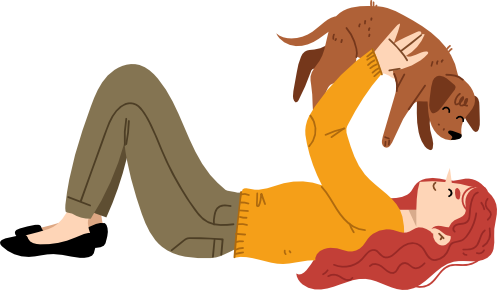It’s a surprisingly common problem: you’re swimming happily, only to suddenly be raked down the back by your dog’s claws. She’s frantically paddling over you – is she trying to save you? But you’re not drowning! And this HURTS!
So why do dogs climb on people when they’re swimming? And how can we stop them from trying to “save” us when we’re not really drowning?
I can’t tell you exactly why your dog does this. I’m not entirely convinced that dogs are trying to save us when they claw us while we’re swimming. Even if they are, they’re doing a bad job of it!
So how do we stop it?
Step One: Prevent the Problem
Like with most training problems, prevention is the first step: you can’t let your dog practice this unwanted behavior.
That might mean putting Fido away with a stuffed Kong during your next pool party, or assigning one family member to go on a beach walk.
This seems obvious and like it’s not quite an answer. I get that. But we’ll never solve the problem if we keep letting it to happen.
So if you’re not ready to be in Dog Trainer Mode, you’ve gotta keep your pup from climbing on swimmers and clawing at them to save them!
Step Two: Practice Basic Skills
Teach your dog skills that will help her cope with the excitement of the pool. The Look at That! Game (practice with exciting things like toys, other dogs, or food at first), Karen Overall’s Relaxation Protocol, and Ready-Set-Down can all be very helpful for the ultimate goal here: teaching your dog to handle exciting situations with grace.
Practice these games in easy situations first, like in your living room after dinner. Eventually start adding in exciting distractions, like food or toys or guests. Then practice near a swimming area when no one is swimming.
But remember: you can’t expect your dog to use a new skill in a tough situation. You’ve got to build up your dog’s abilities before throwing her in the deep end.
Step Three: Take it Live – Starting Small
Once your dog is skilled at lying on a mat (Karen Overall’s game), responding to cues in exciting situations (Ready-Set-Down), and looking at exciting things (Look at That), you can take this show on the road!
Start by having one person (the Trainer) holding the dog’s leash far away from the water. Another person, the Swimmer, is nearby. If the dog can easily respond to known cues (sit, down, shake, etc) and is eating treats easily, introduce the other person.
The Swimmer will approach the water. The Trainer will continue rewarding the dog for responding to known cues.
The Swimmer enters the water. The Trainer will keep asking the dog for known cues, and rewarding her for compliance. If at any point the dog stops being able to respond to training or stops eating treats, end the session for today.
Take a break after 3 minutes of training. If the dog stills seems bright-eyed and engaged, then restart. Otherwise, try again later.
Now the Swimmer will start to splash gently. The Trainer continues asking for known cues and rewarding the dog appropriately.
Now the Swimmer can actually swim. Trainer continues with her tasks.
Take another break after 3 minutes – or earlier if the dog is starting to get over-excited. Again, if the dog can’t listen to known cues, you’re pushing too hard! No need to punish/correct the dog – just go slower. We want this to be fun and easy for the pup.
Once the dog is able to calmly engage in training while someone is swimming at a given distance, it’s time to start letting the dog come closer and closer. Just move the dog and Trainer closer to the water by a few steps at first. Keep the same metrics of success, and be patient!
You’ll be surprised how quickly your dog will be able to calmly watch swimmers and respond to obedience cues, rather than drowning them!
For a video example of this training protocol, watch below.

